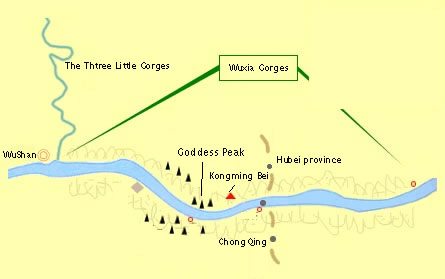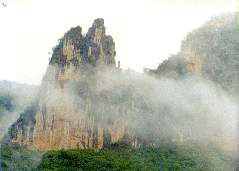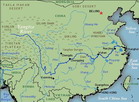2020 Yangtze River Cruise and Ferry Starting from 79 USD p.p.!
Wu Xia (Witches Gorge)
Video A![]()
Video B![]()
Video C![]()
Below Wushan the river approaches
the entrance to the 40-kilometre (25--mile)
long Wu  Gorge,
the middle Yangtze gorge which straddles Sichuan
and Hubei Provinces. So sheer are the cliffs
that it is said the sun rarely penetrates. The
boat passes, on the south side, the Golden Helmet
and Silver Armour Gorge0inkuang Yinjia Xia)
shaped, it is said, like an ancient warrior's
silver coat of arms crowned by a round golden
helmet. Ahead are the l2 peaks of Wu Gorge,
famed frothier dark and somber grace. Poets
have attempted to evoke both their bleakness
and beauty:
Gorge,
the middle Yangtze gorge which straddles Sichuan
and Hubei Provinces. So sheer are the cliffs
that it is said the sun rarely penetrates. The
boat passes, on the south side, the Golden Helmet
and Silver Armour Gorge0inkuang Yinjia Xia)
shaped, it is said, like an ancient warrior's
silver coat of arms crowned by a round golden
helmet. Ahead are the l2 peaks of Wu Gorge,
famed frothier dark and somber grace. Poets
have attempted to evoke both their bleakness
and beauty:
Autumn Thought
Jade dews deeply wilt and
wound the maple woods;
On Witch Mountain, in Witch
Gorge, the air is somber, desolate.
Billowy waves from the river
roar and rush towards the sky
Over the frontier pass, wind
and clouds sink to the darkening earth.
These clustered chrysanthemums,
twice blooming, evoke the tears of yesteryear,
A lonely boat, as ever, is
mooted to the heart that yearns for home.
To cut winter clothes, women
everywhere ply their scissors and foot-rulers
Below the White Emperor's
tall city is heard the urgent pounding of the
evening wash.
Six peaks line the north side:
Climbing Dragon Peak (DengIong Feng)
Sage Spring Peak (Shengquan Feng)
Facing Clouds Peak (Chaoyun Feng)
Goddess Peak (Shennu Feng)
Fir Tree Cone Peak (Songluan Feng)
Congregated immortals Peak (jixian
Feng)
Three peaks flank the south side:
Assembled Cranes Peak 0uhe Feng)
Misty Screen Peak (Cuiping Feng)
Flying Phoenix Peak (Feifeng Feng)
Three more peaks may be glimpsed
behind these:
Clean Altar Peak 0ingtan Feng)
Rising Cloud Peak (Qiyun Feng)
Mounting Aloft Peak (Shangsheng
Feng)
More often than not these green-clad
peaks are hidden by swirls of cloud and mist,
and are difficult to distinguish, though each
has its own characters and posture.
The most famous is the Shennu Feng
(Goddess Peak)--also referred to as observing
the Clouds Peak--which resembles the figure
of a maiden kneeling in front of a piIIar. She
is  believed
to be the embodiment of Yao Ji, the 23rd daughter
of the Queen Mother of the West. Yao Ji, at
the age of 18, was sent to oversee the JadePoo1
of the Western Heaven, accompanied by l l fairy
handmaidens. But she found life there lonely
and cold, and took to rambling among the mountains
and rivers of the mortal world. Wushan became
her favourite place, and there she established
small palace. Once, returning from a visit to
the Eastern Sea on her floating cloud, she came
upon l2 dragons playing havoc with the river
and the mountains, and causing flooding and
hardship in their wake. She summoned Da Yu the
Great from his work on the Yellow River and,
alighting from her cloud, presented him with
heavenly supernatural book. This endowed him
with powers to call upon the wind, rain, thunder
and lightning to move the earth, thus enabling
his sacred ox to s1ashopen the gorges (which
is why all oxen have bent horns), and permit
the waters todr3in into the Eastern Sea. Yao
Ji resolved to stay here with her 11 maidens
to protect the boats from the dangerous rapids,
the peasants' crops from damage, the woodcutters
from wild animals, and to grow the fungus of
longevity for the sick. Eventually these 12
maidens became the 12 sentinel peaks of Wu Gorge.
There are, of course,many variations to this
story.
believed
to be the embodiment of Yao Ji, the 23rd daughter
of the Queen Mother of the West. Yao Ji, at
the age of 18, was sent to oversee the JadePoo1
of the Western Heaven, accompanied by l l fairy
handmaidens. But she found life there lonely
and cold, and took to rambling among the mountains
and rivers of the mortal world. Wushan became
her favourite place, and there she established
small palace. Once, returning from a visit to
the Eastern Sea on her floating cloud, she came
upon l2 dragons playing havoc with the river
and the mountains, and causing flooding and
hardship in their wake. She summoned Da Yu the
Great from his work on the Yellow River and,
alighting from her cloud, presented him with
heavenly supernatural book. This endowed him
with powers to call upon the wind, rain, thunder
and lightning to move the earth, thus enabling
his sacred ox to s1ashopen the gorges (which
is why all oxen have bent horns), and permit
the waters todr3in into the Eastern Sea. Yao
Ji resolved to stay here with her 11 maidens
to protect the boats from the dangerous rapids,
the peasants' crops from damage, the woodcutters
from wild animals, and to grow the fungus of
longevity for the sick. Eventually these 12
maidens became the 12 sentinel peaks of Wu Gorge.
There are, of course,many variations to this
story.
As the river twists and turns, a
mountain comes into view, appearing as if it
wil1block the way. This is Congregated
Immrtals Peak, on whose grey-white rock face
can just be made out a carved inscription, known
as the Kongming Pai, which legend attributed
to the great third-century politician and strategist
Zhuge Liang (see page42). However, it seems
that the inscription was in fact carved during
the Ming Dynasty by the local people to show
their eternal respect and regard for this hero.
Five kilometres (three miles) below
Kongming Pai on the south bank is the small
trading town of Peishi, which marks the provincial
border between Sichuan and Hubei; Whitewashed
villages cling to the mountain terraces which
produce grain crops and fruits--apples, persimmons,
peaches, apricots and Chinese chestnuts.
Just above the north-bank town of
Guandukou--marking the end of WuGorge----was
the site of the Flint Rapid (Huoyan Shi), which
was very violent at high water, with limestone
rocks jutting into the river like huge stone
gates beckoning helpless craft. These, along
with all the dangerous rocks in the shipping
channel, were blown up in the 1950s. Besides
rapids, other dangers to navigators includedwhirlpools,
quicksand and currents which varied from hour
to hour.



